Military
 Friday - July 29, 2011
Friday - July 29, 2011
Prang!
Ah, that explains it. It wasn’t an accidental launch after all, just one that screwed up.
VANDENBERG AIR FORCE BASE, Calif. – An unarmed Minuteman 3 intercontinental ballistic missile was destroyed over the Pacific Ocean early Wednesday, minutes after it blasted out of a California coast underground silo on a flight to test the weapon’s reliability, the Air Force said.
It’s the second Minuteman 3 test problem in five weeks at Vandenberg Air Force Base, located about 130 miles northwest of Los Angeles. The latest Minuteman 3 missile was launched at 3:01 a.m. Wednesday and was destroyed five minutes later because of unspecified safety concerns. Designed to carry a nuclear warhead, the three-stage intercontinental ballistic missile has a range of more than 6,000 miles. It travels to approximately 15,000 mph at an altitude of 700 miles.
Air Force controllers detected “a flight anomaly and terminated the flight for safety reasons,” said Col. Matthew Carroll, chief of safety for Vandenberg’s 30th Space Wing. “Established parameters were exceeded and controllers sent destruct commands,” Carroll said in a statement. “When terminated, the vehicle was in the broad ocean area northeast of Roi-Namur.” Roi-Namur is an island in the northern part of the Kwajalein Atoll in the Marshall Islands, some 4,200 miles from Vandenberg.
There were no details on what went wrong and a Vandenberg spokesman said there won’t be any further information until Thursday. The Air Force said there will be an investigation.
Don’t you just love Mil-Speak? “Established parameters were exceeded” means “our rocket lost control and went spinning across the sky”. That’s what is called a prang.
Posted by Drew458
Filed Under: • Military •
• Comments (0)
 Friday - July 22, 2011
Friday - July 22, 2011
UXB!
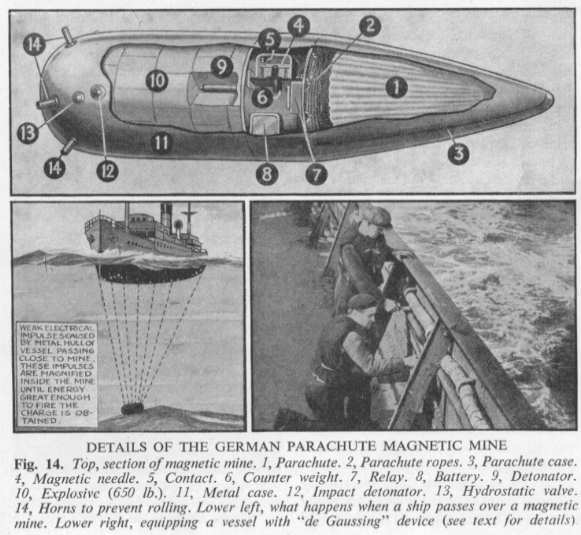
Royal Navy bomb disposal experts have destroyed a large German Second World War mine off the Essex coast, which had been picked up by a dredging vessel.
The 1 500-pound (680kg) Second World War device was dredged up last Friday by the vessel Congo River about seven miles (11km) off Walton-on-the-Naze, the UK’s Ministry of Defence said.
A team from the Royal Navy’s Southern Diving Unit 2 in Portsmouth was faced with an initially risky task of detaching the parachute mine from the vessel before laying it safely on the seabed.
“The mine was in excellent condition - in fact it was still shiny - but the dredger had pierced its skin so this was a delicate task for the team.”
Lieutenant Commander Nekrews praised Chief Petty Officer (Diver) Ian Fleming and Leading Diver Matt Baker for their efforts in safely detaching the mine from the vessel. “They were first on the scene and were faced with a challenging and precarious task but as usual they dealt with it in an extremely professional way,” Nekrews said.
“These type of devices are not uncommon, particularly in that part of the world. There are still tens of thousands of unaccounted for pieces of ordnance from the Second World War scattered throughout northern Europe.”
On April 14 the Dutch minehunter HNLMS Willemstad detected and detonated an extremely heavy German influence mine off the coast of Scotland, which dated back to the Second World War.
On March 22 this year, BP discovered a 3.5 metre long unexploded World War II German mine near one of their pipelines in the North Sea. World War II explosives have been found in the region before – in 2009 the Royal Navy destroyed two WW II explosive charges there.
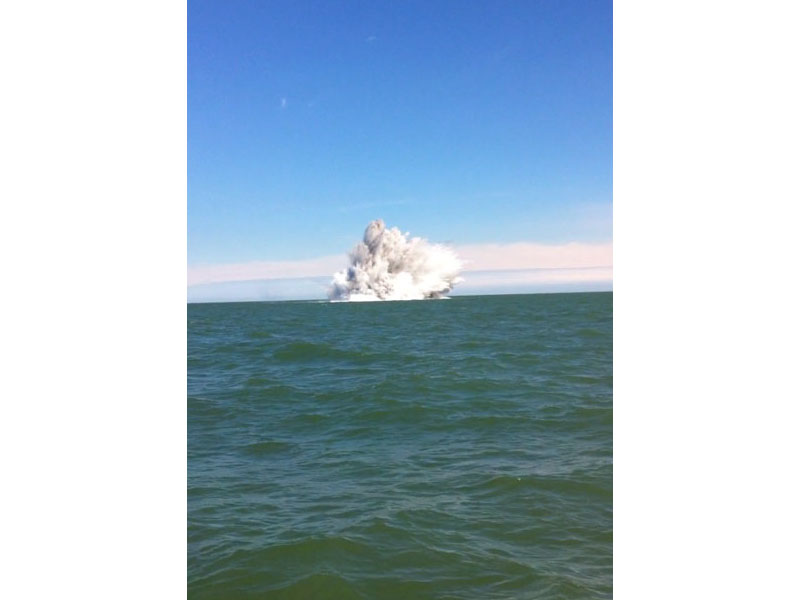
More than 70 years under the ocean, and it still worked just fine.
The Essex coast is north and east of London. This is the northern end of the Channel; Walton-on-the-Naze is actually due west of Rotterdam in the Netherlands. Walton-on-the-Naze is one of those wonderfully named English coastal villages, a suburb of another coastal town called Frinton And Walton; it’s out on a spit of land between the English Channel and a bay named Hamford Water which is east of Colchester. Walton-on-the-Naze is separated from that bay by Horsey Island and a small bend of water called The Twizzle.These names crack me up. Charming, quaint, but I think the Brits used to hold national competitions to see who could come up with the silliest names for places.
Posted by Drew458
Filed Under: • Military • UK •
• Comments (0)
 Sunday - July 17, 2011
Sunday - July 17, 2011
Better Than A Dillon Catalog
Anyone who owns one of the Big Blue Machines knows what I’m talking about. Dillon Precision makes the best and the most expensive ammunition reloading presses on the market. Great tools, guaranteed forever for free no matter what, but pricey. And when you buy one you get sent their little catalog every month for the rest of your life. It’s called the Blue Press, and comes taped closed, and always features an amazingly gorgeous and curvy model on the cover fondling some firearm. It almost looks like porn, because it is. Gun porn I mean. Ok, you get a couple more pictures of the cover model inside, but that’s all. The rest is reloading gear and tactical rifle parts. And that’s all the sexy Dillon delivers, other than the 2 large format calendars they sell every year. Really large format. One for the half of the company that makes reloading machines, and another for the half of the company (Dillon Aerospace) that makes the mini-gun for the military. Both calendars feature plenty of jaw dropping good pictures, but no sleaze.
Gosh, what a surprise: guys find themselves attracted to lovely young women looking dangerous while not wearing much clothing. Who’da thunk it? The calendars sell like mad. Actually they sell out, fast, every year.
I saw a post at Vilmar’s. He didn’t mention it, but he had posted one of the pictures (stolen from Theo’s of course) from this year’s Hot Shots Calendar. To the best of my knowledge Hot Shots has no product for sale other than the calendars. They follow the same theme as Dillon Precision, girls with guns, but donate half the money they get to the UK Help For Heroes foundation, which helps out wounded and disabled vets. Good show.
Here’s another shot of Lucy Pinder from that calendar. Nice rifle. Great smile. This is by far the tamest picture in the whole thing.


The 2012 calendars will feature a less military, more girls from video games motif - cosplay with guns!! - and are available for pre-order now. Not cheap, but half the cash goes to a good charity. About $30 delivered to the USA, but only about £13 in the UK.
Posted by Drew458
Filed Under: • Eye-Candy • Guns and Gun Control • Military •
• Comments (0)
 Wednesday - July 13, 2011
Wednesday - July 13, 2011
Service For Wednesday

Long before Terry Pratchett dreamed up the Nac Mac Feegle and had Paul Kidby paint them going into battle, the Highland Regiments served faithfully in the trenches of the First World War. Doggerel poet Robert W. Service was there, serving in the Ambulance Corps. Finding himself alive at the end of that conflict, he mixed humor and the horrors of war together to find out what it takes to really, really piss off a Scotsman. The result was The Haggis of Robert McPhee, a bit of verse soaked in the Feegle-ish phraseology of Robert Burns, in which our two heroes are sent out past the wire to gather information on the enemy. Severely wounded by a sapper’s mine, one blinded and one with his legs shot off, they work together to get back to their own lines, driven the whole time by the thought of the care package dinner awaiting them, with the promise of a drink of whisky. When another shell hits that meal just as it’s ready to serve, the whole regiment goes over the top in a mad act of revenge. It was of course January 25th when this happened.
Humor in uniform, ages before Reader’s Digest.
Speaking of things a wee bit Scottish ...

The Haggis of Private McPhee
“Hae ye heard whit ma auld mither’s postit tae me?
It fair maks me hamesick,” says Private McPhee.
“And whit did she send ye?” says Private McPhun,
As he cockit his rifle and bleezed at a Hun.
“A haggis! A HAGGIS!” says Private McPhee;
“The brawest big haggis I ever did see.
And think! it’s the morn when fond memory turns
Tae haggis and whuskey—the Birthday o’ Burns.
We maun find a dram; then we’ll ca’ in the rest
O’ the lads, and we’ll hae a Burns’ Nicht wi’ the best.”
The whole thing is here below the fold:
Posted by Drew458
Filed Under: • Eye-Candy • Humor • Military •
• Comments (0)
 Thursday - June 09, 2011
Thursday - June 09, 2011
I Count Four. Did I Miss One Or Two?
WASHINGTON—The Obama administration has intensified the covert U.S. war in Yemen, hitting militant suspects with armed drones and fighter jets, The New York Times reported late Wednesday.
The accelerated campaign has occurred in recent weeks as violent conflict in Yemen has left the government in Sanaa struggling to cling to power, the Times said.
The report, posted on the newspaper’s website, said Yemeni troops that had been battling militants linked to Al Qaeda in the south have been pulled back to the capital. American officials hope the strikes will help prevent militants from consolidating power.
A drone strike by U.S. special operations forces on May 5 targeted U.S.-born Al Qaeda cleric Anwar al-Awlaki, but a malfunction caused rockets to miss him by a matter of minutes, two U.S. officials told The Associated Press. The officials spoke on condition of anonymity to discuss intelligence matters.
The recent operations come after a nearly yearlong pause in American airstrikes, which were halted amid concerns that poor intelligence had led to bungled missions and civilian deaths that were undercutting the goals of the secret campaign.
...
The U.S. campaign in Yemen is led by the Pentagon’s Joint Special Operations Command and is closely coordinated with the CIA, the Times said.
...
[Yemeni President Ali Abdullah] Saleh authorized secret American missions in Yemen in 2009 but placed limits on their scope and has said publicly that all military operations have been conducted by his own troops.
So, let me see if I understand the big picture here. In Libya, we’re indirectly attacking a brutal dictator and supporting Al Qaeda aligned revolutionaries. And the dictator seems to be winning. But in Yemen, we’re supporting a brutal dictator and attacking Al Qaeda aligned revolutionaries. And the revolutionaries seem to be winning.
Did somebody let Obama make the picks for who we’re going to support? Because the guy utterly sucks when it comes to picking anything, from basketball teams, to Olympics hosting cities, to ... you name it. They guy is like Jimmy Carter: whatever he picks, take the opposite, and that will be the right one.
Posted by Drew458
Filed Under: • Military • Obama, The One • War On Terror •
• Comments (0)
 Saturday - June 04, 2011
Saturday - June 04, 2011
Good Timing
Practically the very same day that we hear that shipping insurance costs are skyrocketing due to pirate activity, the US Navy announces that a new group of sailors have learned how to park their boats. Big deal? Yes! These are not just any boats, but the boats of the Riverine Squadrons. And they learned to park them inside other ships, while those ships were at sea. Say what?? Yup, it’s kind of like landing a helicopter inside a cargo plane, while it’s flying. Only wetter, lower, and a bit slower.
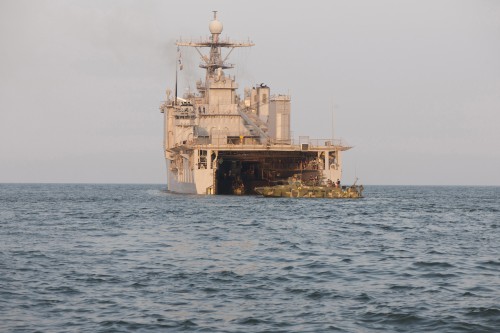
after the completion of a Riverine well deck certification in the Chesapeake Bay, May 31.
By Mass Communication Specialist 2nd Class (SW) Michael R. Hinchcliffe, Navy Expeditionary Combat Command Public Affairs
VIRGINIA BEACH, Va. (NNS)—Sailors from Riverine Squadrons (RIVRON) 2 and 3 made history when they successfully completed the first well deck certification for the Riverine Command Boat (RCB) and Riverine Patrol Boat (RPB) aboard USS Oak Hill (LSD 51) May 31.
“What this proves is that, once and for all, we have the capability with the Riverine Command Boats [RCBs] and Riverine Patrol Boats [RPBs] to bring them on board the well deck of a ship,” said Capt. Christopher Halton, commodore of Riverine Group 1. “With us being able to sustain operations out of the well deck, it opens up a variety of mission sets for the Riverines, from counter piracy missions, supporting amphibious operations or providing force protection for LCACs (Landing Craft, Air Cushioned) operating back and forth to the beach.”
With completion of the well deck certification, the boats have the ability to deploy worldwide aboard an amphibious ship in support of the maritime strategy.
“Once the last boat was clear of the well and it was clear that the events of the day were successful, my well deck team broke out into spontaneous cheers and applause,” said Cmdr. David Bauer, commanding officer of USS Oak Hill. “They knew the importance of what they had just done. It was a very moving moment.”
The Riverine Force, part of Navy Expeditionary Combat Command, is a combat-arms force that performs point defense, fire support and interdiction operations along inland water ways to defeat enemies and support U.S. Marines and coalition forces.
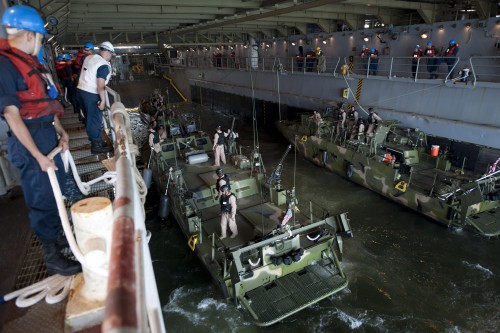
“The RCB was designed with the focus of being a mobile command and control boat, with the ability to control smaller Riverine boats up river,” said Cmdr. Clay Wilson, commanding officer of RIVRON 2. “We’ve kind of pulled it (Riverine mission) out towards the coastal environment right now to fill Riverine needs and the craft has proven to be capable of doing more then just inshore missions.”
The PCB is the small semi-rigid flotation collared special ops craft we’re all familiar with. If you can’t make out the one by the ramp in the above picture, click here for a huge version of a similar pic. They are built by SAFE Boats for the Navy and the Marines in several sizes and configurations. The one is the the picture looks quite small, like it was based on their Oswald model, only with inboard engines and jet thrusters. SAFE Boats also builds the PCB, which is a licensed version of the Swedish CB90. It’s a 49 foot long 50mph gun platform that can carry 2 dozen troops for almost 500 miles, and only draws a couple feet of water. Note how the two in the photo are armed, one fairly bristles with barrel stabilized .50 BMGs, M60s, and mini-guns, the other one appears to have a small autocannon or grenade launcher on top. Both have flush mounted dual .50s in front, controlled remotely from the cockpit. The Oak Hill is a Harpers Ferry class Dock Landing Ship, which means it was built for amphibious warfare, and carries several helicopters on the back, a number of high speed hovercraft or riverine craft inside, a bevy of missiles and self defense system, plus a few hundred US Marines eager to get sand in their boots. A bit more than you’d think would be needed to stop a few Somali pirates at sea, but they have to land somewhere with their hostages, right? Wink wink, nudge nudge, know what I mean? Or, as the Navy puts it ...
If the Stryker armored combat vehicle were a boat, it might be the CB90, a Swedish-designed shallow-water vessel that’s fast, lethal and flexible enough to be an ambulance or a fast-attack craft.
...
Powered by Swedish-built Scania engines, it has a Rolls-Royce jet-propulsion system that allows speeds of more than 43 knots. Meant to operate in rivers and other shallow waterways, it has a three-foot draft.
...
Depending on the mission, it can bristle with weapons from six different mounts. Wood said the boat on order has a remote-controlled weapon mount for a .50-caliber machine gun — or other weapon — on a mast behind the cockpit. It will also have a twin weapon mount on the bow that is controlled from the cockpit, as well as four mounts for crew-served weapons elsewhere on the boat.
As for a possible new set of mission parameters (Oak Hill had earlier served in Iraq but after a South America cruise finally took time out for repairs and maintenance) ... the Riverine group might be a fighting force without a battle right now, which means they could get the budget axe. So matching speedy little gunboat against less speedy, less gunny Somali gunboats may be their salvation ...
ABOARD THE DOCK LANDING SHIP OAK HILL — The prospect of meeting a sleek, armored riverine command boat and its fearsome array of .50-caliber machine guns at sea would undoubtedly induce second thoughts among pirates who prey on shipping in the Gulf of Aden.
...
Riverine force leaders gave the demonstration a thumbs-up. If senior Navy leaders agree, the riverine force could find itself with a new post-Iraq war mission set outside the green-water arena for which it is designed, and the Navy with yet another capability for the flexible and heavily deployed amphibious force.
Next up will be some rough water testing. If these smallish RPBs and RCBs can get in and out of the water wells in open ocean conditions, then the whole dock landing ship group could have a new lease on life chasing pirates from the high seas right up onto the beaches. If not, then it could be mothballs for the motherships, since the patrol boats and the helicopters can ride piggyback on just about any decent size Navy ship. And if the mission plan doesn’t include putting hundreds of US Marines ashore, then these ships could be surplused for now.
Posted by Drew458
Filed Under: • Military •
• Comments (0)
 Friday - June 03, 2011
Friday - June 03, 2011
Boomski Boomski
Last week:

Explosions caused by a fire at a military ammunition depot in the Russian republic of Bashkortostan nearly a week ago have finally ceased, RFE/RL’s Tatar-Bashkir and Russian services report.
The fire and explosions started at a military base northeast of the republic’s capital, Ufa, on May 26.
Some of those who had been among more than 7,000 local residents evacuated from the area last week started returning to the village of Urman in the Iglino district on June 1.
Those whose homes are situated close to the burning military facility are still unable to return home because the fire is still burning.
More than 116 people were made homeless by the incident, 12 were injured, and some 500 left unemployed after their businesses were destroyed by the fire and explosions.
Bashkortostan Security Council head Marat Magadeev told journalists that new homes will be built and finished by August for those who are homeless.
Firefighters were able to enter the base on the morning of June 1 after the explosions stopped. Magadeev told journalists that heavy rain is currently helping to extinguish the blaze.
Moscow - A Russian ammo dump caught fire for the second time in a week on Monday, with exploding munitions forcing a repeat evacuation of hundreds of people.
Firefighters were having difficulty approaching the artillery ammunition depot in Russia’s Central Asian Bashkorstan province because of shell explosions and flying metal, according to news reports.
More than 1,000 residents of the nearby village of Urman abandoned their homes aboard buses provided by local officials, the Interfax news agency reported.
It was not clear from early reports what caused the fire. The blaze came in the wake of a Thursday conflagration at the same storage site. Army investigators have blamed a soldier who allegedly
tossed live shell casings into a pile, which is believed to have touched off one of the shell detonators.
This week:
PUGACHYOVO, Russia—A fire at a military base in the Russian republic of Udmurtia is causing a series of strong explosions, forcing authorities to evacuate thousands of people, RFE/RL’s Russian and Tatar-Bashkir services report.
According to RFE/RL’s services, some 150 buildings—including 18 ammunition depots—are currently on fire at the military base near the village of Pugachyovo. The fire started around midnight on June 2.
Officials say that up to 10,000 train cars full of ammunition may be inside the base.
Udmurtia’s Health Ministry said 50 people have been injured in the incident thus far, 25 of whom have been hospitalized.
...
An estimated 28,000 people have been evacuated from Pugachyovo and nearby villages, including those living in the neighboring Republic of Tatarstan.
...
Explosions from within the ammunition depots can be heard regularly. Most of the buildings on fire are not yet fully destroyed but their roofs and windows are severely damaged.Local authorities have blocked the highway that goes from Yelabuga to Perm. The radius of debris from the exploding ammunition is about two kilometers around the military base.
The incident at Pugachyovo is the second large-scale fire and resulting explosions at a Russian military base in the past week.
A total of 200 personnel, 30 fire fighting units and three fire fighting trains have been deployed, although it was early to move them to the still exploding depot, Vesti TV channel said. The Russian Emergencies Ministry has also rushed two Il-76 fire fighting aircrafts, each able to carry 42 metric tons of water [approx. 11,550 gallons]. The accident has forced the ministry to temporarily close the Yelabuga-Izhevsk zone of the M7 federal highway, connecting Moscow and Ufa, the capital of the Urals republic of Bashkortostan. The nearby railway line was also closed.
Large explosion at Russian military base closes oil pipeline
Flames ripped through the military complex near the city of Izhevsk, 750 miles east of Moscow, on Friday causing the evacuation 28,000 residents. The fire killed two people and injured at least 45 according to Russian media reports. Russian pipeline owner Transneft said that it was not receiving the 161,000 barrels of oil that it usually gets each day from the region.Video posted on a social media website purportedly shows the complex on fire with lit ammunition shooting into the sky like fireworks amid large fireballs. Russian agencies reported that the base stored 10,000 tonnes of shells and ammunition, equivalent in power to about 58,000 tonnes of TNT.
I’ll refrain from making any trite remarks about roasted taters and 12 steppe plans.
Pugachevo and Ufa are about 200 miles apart, and both are located a few hundred miles north of Kazakhstan’s northwestern frontier, north of the Caspian Sea. Kazakhstan is an oil and gas rich former Soviet republic that has been ruled by the same guy, Nursultan Nazarbayev, since 1989. The country is about half muzzie, maybe more. Nazabeyev recently won a surprise election with 95% of the vote.
Kazakhstan has come under repeated fire for instituting effective one-party rule in which all political and economic decisions are made by Nazarbayev and his hand-picked ministers and assistants.
But this closed system has pursued a decade of business-friendly policies that have ensured 8.5 percent annual growth and a dramatic improvement in the lives of the 16.4 million people living across the vast country’s steppes.
Posted by Drew458
Filed Under: • International • Military •
• Comments (0)
 Wednesday - May 25, 2011
Wednesday - May 25, 2011
Still Not Working
That’s the proper thing to say, isn’t it? Any war any US president gets us involved in that isn’t done, won, and over in 3 months is another Vietnam, right? An endless quagmire with no possibility of victory ever? A pointless military money pit? Don’t blame me; I’m just following established journalistic precedents.
Without any real discussion with the legislature or the American people, Obama started bombing Libya March 19th. It’s almost June. So it’s not quite 90 days, but “only” 66, yet there is no end game in sight, and no exit strategy carved in stone. I’m pretty sure there isn’t even any congressional approval yet; this is Obama’s personal military action. And it’s a pointless one at that; he’s not trying to be “gutsy” and take down Gadhaffi. He’s not feeding arms to the Libyan rebels so that they can win and “free” their country. He’s not even making sure the US Navy is leading the way; some euro-dude somewhere is literally calling the shots, and US forces are doing the grunt work. Our guys aren’t even paid mercenaries; the Libya adventure has cost the US taxpayer nearly a billion dollars at this point. And like Kosovo, Iraq, and Afghanistan, it’s become part of the new normal so quickly that it’s barely even news any more. Nothing to see here, move along. But in 3 weeks will things have changed one whit?
NATO warplanes pounded Tripoli for a second day, raising military pressure on Muammar Gaddafi while diplomatic efforts mounted to force his departure.
Six loud explosions rocked Tripoli late on Tuesday within 10 minutes, following powerful strikes 24 hours earlier, including one on Gaddafi’s compound, that Libyan officials said killed 19 people and state television blamed on “colonialist crusaders.”
A NATO official said the alliance hit a vehicle storage bunker, a missile storage and maintenance site and a command- and-control site on the outskirts of Tripoli. Government targets around the Western rebel outpost of Misrata had also been hit.
“We were quite active in the past 24 hours and will continue to be so,” the official said. “Striking fighting units and people trying to give the orders is having the desired effect.”
Libyan news agency Jana says NATO hit a telecommunications station in Zlitan overnight, causing “material and human casualties losses” west of Misrata.
British Foreign Secretary William Hague dismissed fears that Western states were being drawn into an Iraq-style conflict. “It’s very different from Iraq because of course in the case of Iraq there were very large numbers of ground forces deployed from Western nations,” Hague told BBC Radio on Wednesday.
France, Britain and the United States are leading the air strikes, which began on March 19 after the U.N. Security Council authorized “all necessary measures” to protect civilians from Gaddafi’s forces as he sought to crush an uprising against his 41-year rule.
The three countries say they will keep up the campaign until Gaddafi leaves power. French Foreign Minister Alain Juppe said on Tuesday that the NATO bombing campaign was making progress and should achieve its objectives within months.
Sure it will. It’s been months already. Last time I looked, Libya had about 5 cities. The rebels seem to be in control of at least 2 of them. The rest of the country is sand. Empty. Desert. Bedouins and Tauregs; random rare nomads on camels. There is nothing there. How long does it take to blow up nothing? Look, if you want old Mohmar gone, take him out. Oh, it’s against US policy? Here’s your solution: this Zuma guy from Africa is coming to visit Gadhaffi next week. Put a tracking buy on him. Slave a satellite for a couple days. When he’s actually meeting with the sand rat, mark the location, then use your spy satellite and some high altitude UAVs to follow every vehicle that leaves that meeting. And have NATO drop a bomb on each one 10 minutes later. Odds are pretty good you’ll get him, with plausible deniability.
What happens to Libya once Mohmar is wall splatter? Who knows? Who cares? Not Obama. But at that point he can make a claim for another round of gutsy non-spiking of another football, and we can stop pissing away tax money by the ship load.
Posted by Drew458
Filed Under: • Middle-East • Military •
• Comments (1)
 Tuesday - May 10, 2011
Tuesday - May 10, 2011
And Then There Were None
I missed this last week.
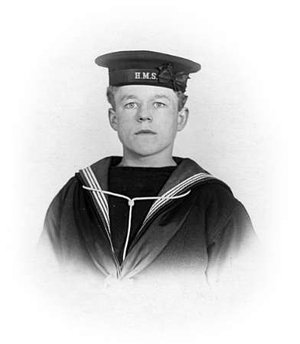
(May 5 2011) Claude Choules, the only remaining male veteran of World War I and one of the last people to have served in both world wars, died May 5 at a nursing home near Perth in western Australia. He was 110, and no cause of death was reported.
The former seaman, who was underage when he signed up for duty, witnessed the surrender of the German Imperial Navy in 1918. He also watched as German sailors scuttled their own fleet at Scapa Flow, near Scotland, to avoid having the ships fall into British hands after the war.
Mr. Choules and another Briton, Florence Green, became the war’s last known surviving service members after the death of American Frank Buckles in February, according to the Order of the First World War, a U.S.-based group that tracks veterans.
Mr. Choules was the last known surviving combatant of the war. Green, who turned 110 in February, served as a waitress in the Women’s Royal Air Force.
...
He lied about his age so he could join the British Royal Navy in 1916, two years after the Great War began. Enlistees were supposed to be at least 18 years old.
He was the last known male survivor of more than 70 million military personnel who served during WWI. And it looks like Mrs. Green is the last living person who was even remotely connected to that conflict. She joined the WRAF shortly before the war ended in 1918 and served on an air base in Marham in Norfolk. Choules turned 110 on March 3.

RAF Marham was opened in 1916 and is still in use today, being the home base of the Tornadoes doing air strikes against Libya.
Posted by Drew458
Filed Under: • Military •
• Comments (0)
 Monday - April 25, 2011
Monday - April 25, 2011
Shed A Tear And Raise A Beer
I won’t be around Sunday or Monday, maybe not even Saturday, so I’ll put this together now and set it to appear Monday. I was reminded today (Friday) that it was almost time by a video at Theo’s. He posted The Fureys doing The Green Fields of France, a WWI remembrance video by this Irish folk band. The Irish fought in WWI, but under the flag of Great Britain.
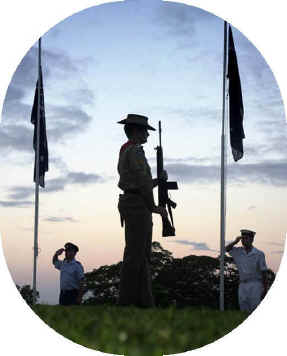
ANZAC Day is a big thing Down Under in Australia and New Zealand. It is their own personal Remembrance Day, in honor of their first international military engagement as commonwealth nations. It’s also a celebration of the birth of their own national spirit.
Around the turn of the 20th century Australia and New Zealand became Commonwealth Nations in the British Empire. In 1915 183,000 Australian and New Zealand soldiers took part in the Dardanelles campaign, an attempt to capture Istanbul and open the passage from the eastern Mediterranean to the Black Sea. Success there would have crippled the Ottoman Empire, an ally of Germany in WWI, and taken pressure off of Russia in the Crimean. Russia held the Eastern Front against Germany. On April 25, 1915 the ANZAC (Australian and New Zealand Army Corps) forces landed near the mouth of the Sea of Marmara at the eastern end of the Gallipoli peninsula. It was a pure cluster f*** from the beginning.
Because of a navigational error, the ANZACs came ashore about a mile north of the intended landing point. Instead of facing the expected beach and gentle slope they found themselves at the bottom of steep cliffs, offering the few Turkish defenders an ideal defensive position. Of the 1500 men who waded ashore that first day, 755 remained in active service at the end of the day. The remainder were killed or wounded. Establishing a foothold, the ANZACs found an advance to be impossible.
And there they fought, and there they died.
8 full months of hell later they were evacuated. Net achievement: zero. The campaign was one of the worst run in history, combining terrible logistics, terribly inaccurate supporting fire, criminally poor leadership, and poor food with horrible living conditions, no sanitation whatsoever, primitive medical support even for the day, and a number of virulent outbreaks of disease. In the end it was a defeat for the Allied forces, but from purely a numbers perspective it was a victory, because 3 times as many Ottomans died as did Allies.
The campaign is often referred to for its successful stealthy retreat, which was completed with minimal casualties, the ANZAC forces completed their retreat by 19 December 1915 and the remaining British elements by 9 January 1916.
Total Allied deaths were 43,000 British (10% of them Irish), 15,000 French, 8,700 Australians, 2,700 New Zealanders and 1,370 Indians. Total Turkish deaths were around 200,000. New Zealanders suffered the highest percentage of Allied deaths when compared with population size, but the percentage of Turkish deaths was almost twice theirs.
This campaign became a turning point in the national consciousness of several of the participants. Both Australia and New Zealand still celebrate Anzac Day and the Turks consider it a point of national pride. Many mementos of the Gallipoli campaign can be seen in the museum at the Australian War Memorial in Canberra, Australia, and at the Auckland War Memorial Museum in Auckland, New Zealand.
The last ANZAC veteran of Gallipoli, Alec Campell, died in 2002.
Over time ANZAC Day became not just a remembrance of those who died or were wounded in that far off event, but a day to honor all those who had served. And as the years went by, remembrance turned more to celebration, because it was in Gallipoli’s filthy sands that these two island peoples first stood up for their own nationhood.
As dawn breaks over Trinity Inlet on Anzac Day on Monday, a record crowd is expected to gather at the Cenotaph on Cairns’ Esplanade to remember our fallen Diggers. And it’s a scene that will be repeated all over Australia and the Far North – from a dawn parade in cyclone-ravaged Cardwell to a morning service at the Yorkeys Knob Boating Club.
Far Northern RSLs say the number of people who attend local services grows each year, as more residents are touched by war and the Anzac spirit cements itself in the national identity. Cairns RSL committee member David Clifton said Australia had shaken off the divide that lingered after the Vietnam War and now Anzac Day was a time to celebrate the nation’s unique spirit.
“A lot of those divisions that arose after Vietnam, which really split people’s attitudes, have healed, and that divide is less relevant today,” he said. “Now the country celebrates Anzac Day. Rather than commemorating it with great sadness, we honour the efforts of men and women in service and celebrate their spirit.”
And the old men march slowly, old bones stiff and sore. They’re tired old heroes from a forgotten war
And the young people ask, what are they marching for? And I ask myself the same question.
But the band plays Waltzing Matilda, and the old men still answer the call,
But as year follows year, more old men disappear. Someday no one will march there at all.
Waltzing Matilda, Waltzing Matilda, who’ll come a-waltzing Matilda with me?
And their ghosts may be heard as they march by that billabong, who’ll come a-waltzing Matilda with me?
Posted by Drew458
Filed Under: • Military •
• Comments (2)
 Wednesday - April 20, 2011
Wednesday - April 20, 2011
How to make your electric company fall in love
It’s easy! Just set one of these up in your backyard, and fire it off every minute or two. Hey, I didn’t say the FAA and the fire department was gonna love you, just the electric company.
h/t to Rich K
A little fun video from our pals at General Atomics. I say “our pals” because anyone who can launch a couple of kilos of metal at 6700fps is someone I want to have on my side.
Railgun launches are nothing new. What makes this one new is that they finally got around to actually using an aerodynamic projectile, wrapped up in a discarding sabot

Rather looks like a “personal size” V2 doesn’t it? And to think that the Germans figured out that shape 68 years ago.
Anyway, these guys fired off the projectile, and it shot through a steel plate a hundred yards away, and then flew another 7km before hitting the ground. And that shot was done with no elevation, so it was a horizontal trajectory. Angle the gun up and I bet you could shoot their little dart 200 miles or more.
The kinetic energy of such a projectile is up in the megajoule range, several million pound/feet worth. Surprisingly, railguns - which run on electricity - don’t really use all that much total energy. Each shot eats up about the same amount of power it would take to bake a ham in an electric oven. But while it takes a couple hours to do your ham, the railgun uses that much power in a bit less than half a millisecond.
So if it’s all-electric, why is there such a huge plume of fire coming out of the gun? It only looks like fire. It’s actually plasma interacting with the atmosphere. Which I guess does make it actual fire. Duh. But the plasma is there because a) such an awesome wallop of electricity ablates a large chunk of the sabot, and b) the projectile probably catches on fire just from the speed it’s going. It certainly is moving fast enough to c) instantly ionize the air in it’s path, and I’m pretty sure that more plasma is the result of that.
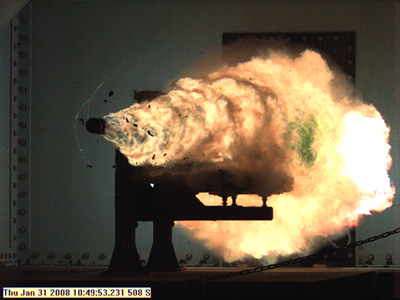
vidcap from a railgun launch from 2008.
Posted by Drew458
Filed Under: • Amazing Science and Discoveries • High Tech • Military •
• Comments (3)
 Friday - April 15, 2011
Friday - April 15, 2011
LAAR She Blows! Part Two
Alright, I took a few hours off to eat and hang out and watch tonight’s episode of Fringe. Ok, so where was I? Ah yes ...
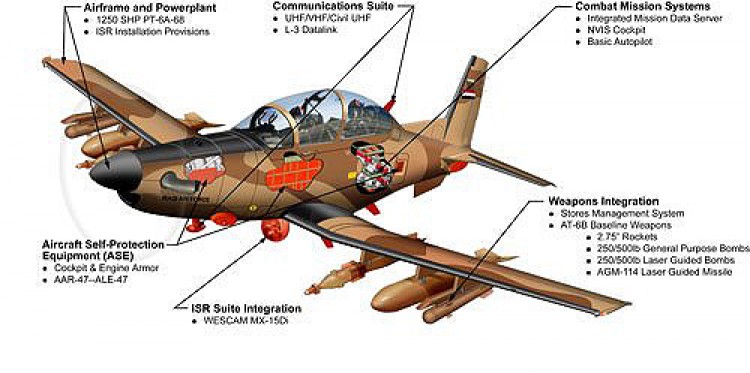
It looks like the Navy and the Air Force both want some kind of smallish airplane that can handle the small scale low level situations that seem to be a big part of modern “asymmetrical” warfare. I think that’s defined as a fight between a well trained, fully equipped modern force and a D level pick up squad of rag tag Turd World losers, with a specific ROE that applies only to the bigger force so that they are never actually allowed to win.
Such a small plane needs to be fairly low maintenance, and it needs to be able to engage the enemy out past the range of heavy machine guns or smaller 20-40mm anti-aircraft fire. That’s about the best we’re going to face from drug cartels, tin hat dictators from the poorer nations, and Al Qeda in general. Anything bigger and it will be an actual war between actual nations, and we’ve got plenty of big stuff for those. But just in case the scrub army should get it’s hands on some second hand missiles, let’s write the specs to include a few million dollars worth of threat detection computers, anti-missile systems, chaff dispensers and so forth. Seriously, I’m only being a little sarcastic. The specs I could find read less like an airplane and more like a toy box:
The aircraft will carry ordnance and external stores on four underwing pylons. Typical air-to-ground ordnance will include an aerial cannon, two 500 lb class guided-munitions and a variety lighter weapons, such as 2.75” (guided or unguided) rockets, rail-launched guided missiles (such as the Hellfire II), unguided free-fall munitions, flares etc. It will be capable operating on five - hour missions, flying distances of 900 nautical miles without refueling, up to a ceiling of 30,000 ft. The aircraft will operate from austere, forward operating bases, semi-prepared surfaces including dirt, grass, gravel, surfaces. Ground support operations are not rquired ro service the aircraft, - other than available field fuel stores available for re-fueling operations.
...
Configured as tandem cockpit with duplicated controls and modern digital avionics, LAAR will be designed for day or night operation. The front cockpit will also be fitted with a HUD supporting air-to-ground functionality, displaying the continuously computed impact point (CCIP), continuously computed release point (CCRP), strafe, and manual weapon aiming computation/release.The ISR systems on board will comprise a modern, stabilized multi-sensor electro-optical payload with geo-locating accuracy, integrating a day channel, night (thermal) channel, and multiple laser emitters, such as rangefinder, designator, target marker and spot-tracker. LAAR will be equipped with communications systems, integrating voice-and-data links, enabling simultaneous operation of three separate channels, in addition to multiple datalinks supporting transfer messaging, images and full motion -video supporting Remote Operations Video Enhanced Receiver (ROVER), operated by ground units and the ground forward air control / joint terminal attack control (FAC/JTAC) systems. LAAR will operate fully integrated with traditional Command and Control (C2) concepts and organizations, networked with current theater air tasking order (ATO) and airspace control order (ACO) dissemination networks.
Yeah. You can get a serious case of acronymia reading these things. So they want a little plane that has all the big plane gizmos inside, with a multi-channel real-time data link and one of those rotating ball spy camera thingies like on the UAVs. Or, as the guy from Beechcraft put it 7 months ago:
The AT-6 is a structurally enhanced Beechcraft T-6A/B airframe with a more powerful Pratt & Whitney PT6A-68D engine, and a Lockheed Martin A-10C Mission System that is integrated with the T-6B primary flight avionics system. It also has the same sensor suite as the MC-12W with a laser designator/range finder. ”When our airplane wakes up in the morning, it believes it’s an A-10. We call this simple integration,”
“Simple integration”. What an excellent misnomer. But if it works, go for it.
Anyway, to make a very short story even longer, it looks like two airplanes are under consideration. One, the above mentioned Beechcraft, currently called the AT-6B, made in Kansas I think, and the other one, the Brazilian Embraer Super Tucano EMB-314. They look amazingly alike.
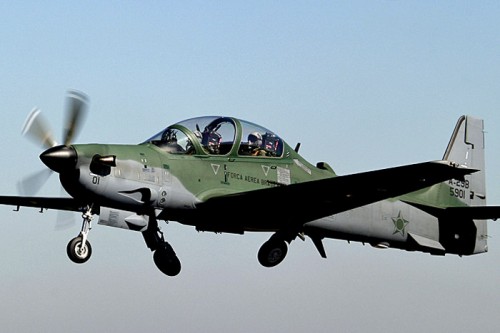
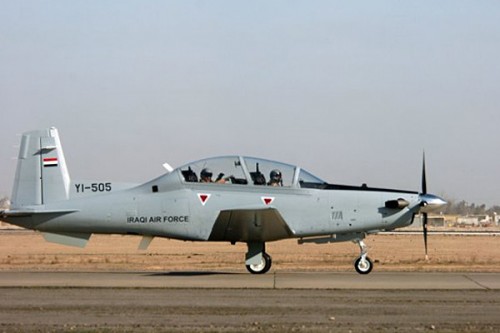
“Still, they’re cousins,
Identical cousins and you’ll find,
They laugh alike, they walk alike,
At times they even talk alike—
You can lose your mind,
When cousins —are two of a kind. “
Here’s where the real differences lie: the Beechcraft was built as a trainer. To make the grade as an LAAR craft, it has to have major upgrades, starting with a bigger engine with nearly 50% more power, a significantly strengthened airframe to handle that power, hardpoints designed and installed, wing redesign, and all sorts of room found for wing guns and all that fancy electronics gear. It even needs bigger tires. The Super Tucano was designed from the ground up to be a military aircraft for rough airstrips. It already has the stronger engine and body, the ISR ball turret laser target designator, hardpoints, etc. It has some of the fancy electronics, but not our latest kit.
What the Super Tucano does not have is our latest and greatest ejection seats. These things are called Zero/Zero seats, which means they can blast you out of a busted airplane far enough for your parachute to deploy safely even if the airplane itself is at zero altitude going zero speed. And our latest version can be adjusted to fit every body type from a 103lb petite woman to a fairly large 245lb man. Can such seats be retrofit? I bet they can.
What the AT-6B doesn’t have is much of any actual existence. Hawker Beechcraft sells the basic trainer to everyone, and it’s a fine little plane. Meanwhile Brazil is busy selling their little plane all around the world as a combat aircraft, garnering a great reputation in small scale military engagements and drug interdictions. Hawker Beechcraft is redesigning their trainer in steps. Step 1 is to stick in the same engine that the Super Tucano uses ...
In additon to the bigger engine, the aircraft will get the mission system from the upgraded A-10C, with satcom, datalinks, full-motion-video downlink, missile warning, countermeasures, armor and fuel-tank protection. A high-definition color EO/IR sensor with laser designator will be carried on a hardpoint under the fuselage and six underwing stations will carry gun and rocket pods, 250lb or 500lb precision-guided bombs, Hellfire missiles and guided rockets.
The aircraft is being developed in steps. An avionics prototype, AT-1, is flying now with the CMC Electronics digital cockpit avionics and displays. This will be modified towards year-end to integrate and test tle Lockheed Martin mission system. Work has started on a second prototype, AT-2, that will have the big engine and other changes.
The Embraer folks at AFA were quick to point out that the EMB-314 doesn’t need any changes, other than specific equipment, to meet the LAAR requirement. The Super Tucano was designed from the outset as a light-attack/armed-reconnaissance/advanced trainer and has the big engine, ISR ball and even .50-cal guns in the wing.
So it looks like a game of catch-up is going on ... while we’re busy fighting 3 or 4 wars and have a screaming need for some kind of interdiction warplane to fly along our own borders.
The upgrade path isn’t completely smooth either. As you can see in the pic at the top here or inpictures of the AT-6B at airliners.net (who’s pictures I didn’t use because they’re very possessive about such things) they stuck the ISR ball on directly underneath the wings. Probably right on the center of gravity, which makes sense, until you actually fly the plane. Try tracking something when you have to turn and bank; the wing immediately gets in the way, blocking the view/signal. That’s well written up in a long flight review, here.
Do I have faith that the final AT-6B will be a fine little airplane that more than meets the design and mission criteria? Without a doubt. One of the real questions is just how badly we need such an aircraft, and in what numbers. When you draw up the multi-circle Venn diagram with all our different UAVs, our helicopters, our jet fighters, spy planes, V-22 Ospreys, and everything else we have that flies in the mix, how big is the hole that is left unfilled, and how much blood is leaking out that hole? In other words, do we really need this thing, and if we do, do we really need it right the heck now and in big numbers?
And this is where politics creeps in. “Save American Jobs!!” scream the congresscritters in DC. “Don’t outsource our weapons systems!” And they may have a point, even though a deal of this size would be exactly what Obama would have talked about when he was just down in Brazil the other week, talking with their newly elected President, who just happens to be a Marxist and a former jungle revolutionary. And lest you think our legislators are being more hypocritical than usual (we sell our military stuff the world over, but can’t buy any foreign stuff? What part of Free Trade or NAFTA/CAFTA/SAFTA is that?), the Brazilian airplane comes with an odd rider in the contract called a “Golden Share”.
The Golden Share allows the Brazilian government to maintain direct control and veto rights over the “creation and/or alteration of military programs, whether or not involving the Federative Republic of Brazil” as well as the “interruption of the supply of maintenance and replacement parts for military aircraft.”
The Brazilian government’s direct control over Embraer would put the production of the light attack and reconnaissance aircraft at the mercy and whim of Brazil’s political leaders who too often do not see eye to eye with the United States on foreign policy issues. In fact, they have been noticeably absent from the War on Terror over the last decade.
Brazil doesn’t like the no-fly thing over Libya either. I think we ran up against a similar situation during Gulf War I or II, when the Scandinavian company who made our hand grenades didn’t like our involvement there and stopped selling them to us. Or maybe it was rifle ammunition. I can’t recall. Anyway, our troops went through a shortage until we resourced.
So what’s my final opinion? Either one of these little goofy looking airplanes is probably more than enough to fight mini-wars with against rag tag armies and drug lords. Both can fly at 300mph or a touch faster, both can go more than 1000 miles on a tank of fuel. Both can attack targets from 2 miles up in the sky, an altitude where little planes are nearly invisible from the ground. Neither one of these airplanes is going to hold up for shit once actual large bullets and flack start impacting. There is a reason the Thunderbolts both old and new were so overbuilt: they could take a pounding and keep on fighting. Both of these airplanes look mighty fragile to me, especially their scrawny little wings. The cost of all the electronics goodies both use is mighty prohibitive, but that’s what happens when you demand warfare with the precision of eye surgery. Ten million dollars a plane for starters, to drop half million dollar ordnance on angry peasants who won’t earn $5000 in their entire lives and are shooting back with $200 weapons. But they can save fuel and maintenance costs!!!! Yes, but at what expense? Another billion or three? Or ten? In a way they remind me of the VW pickup truck that somebody left in the comments on the automotive post I did yesterday - sure looks great, costs a fortune, and may not really fill any existing market niche. So let’s use a little common sense for once. If we really, really need this kind of plane, and our guys are dying for the lack of it, let’s order up a bunch from Brazil right now and another bunch to use as spare parts. That way we can tell them to FO if they get uppity. And if we don’t absolutely positively have to have these, but it would be nice, then let’s stick with Hawker Beechcraft’s development, put in an iron clad order for 250 of them, and then cut funding for at least two other flight systems. I don’t care if that’s UAVs, super fighters, stealth frisbees or what. There’s only so much money to be spent on toys, and the toy box looks pretty damn full from here.
Done. Hope you’re happy John.
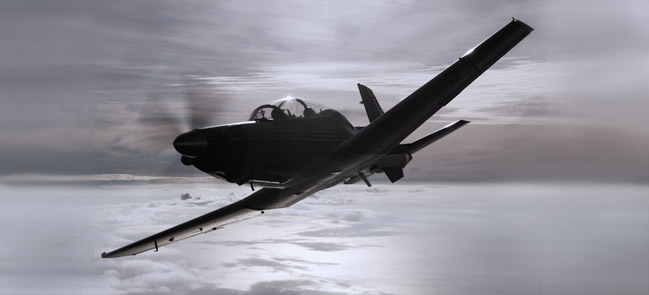
Below the fold are enough links to keep you reading for many hours, but there is one link there you should follow. Have fun!
Posted by Drew458
Filed Under: • Military • planes, trains, tanks, ships, machines, automobiles •
• Comments (9)
LAAR She Blows! Part One
used to force a winner in an aircraft competition
that reinvents the wheel for at least the 3rd time
because the definition keeps changing
That has to be the longest post title I’ve ever used. I’m going to try and keep this post as concise as possible, but that won’t be easy. RightWingNews asked me to stick my oar in the water about the flap over the choice of aircraft for the LAAR mission profile. Should the US choose the US built Hawker-Beechcraft AT-6B, or the Brazilian built Embraer Super Tucano? Both are decent little airplanes with similar performance specs, and both would cost the taxpayers ridiculous amounts of money when put into service, primarily because of all the bells, whistles, digital gee-gaws and other wonderland gimgcrackery the Air Force demands get added on to aid the flight crew with their onerous mission of flying somewhere slowly, shooting 3 raggies on a camel, and then flying slowly home. So before I get into details and politics, let’s step back a second and figure out what this “necessary” mission is, and why it demands a whole new airplane.
LAAR stands for Light Attack and Armed Reconnaissance. It’s fly-guy speak for a catch all mission category that sort of includes flying somewhere, looking around, blowing a few things up, providing a moderate amount of support (ie bullets and small rockets or missiles) to ground troops, may include ground rescue of a small number of troops, and usually includes the ability to take off and land on less than perfect runways. And that’s where the problem is. Because the definition keeps changing, the requirements for a suitable aircraft keep changing. These days the definition includes low levels of maintenance by stupid people, which is my rendition of the USAF’s more diplomatic way of saying we want to also sell these planes to other nations who may not have the best ground crews.
Once upon a time, before and during WWII, when the military wanted to fly somewhere and see what was up they had a couple of airplanes just for that. If it was a short flight over land, the Army had their version of a Piper Cub, a little bitty plane borrowed from the civilian aviation world. It could take off and land on a postage stamp, it flew along slow enough that if it was a car it wouldn’t get a speeding ticket on the highways in NJ, and it could carry a pilot and his camera a good distance out and back. If it was a long flight over water, the Navy had their PBY Catalina. It wasn’t fast either, but it could go a very long way and if it ran out of gas you could land it in the ocean. The PBY was big enough to have a few guys onboard, and could carry a machine gun or two to defend itself or provide very limited ground support. Come to think of it, a new PBY with a couple of little missiles hung on the wings would be a superb airplane for dealing with Somali pirates.
Neither of these airplanes was suited for any kind of actual combat. When getting shot at crept into the mission definition, reconnaissance was done by fighters and bombers that had a gun or two removed and cameras put in. It worked, and at a fairly low cost.
After that war, and during and after the Korean war, the mission changed again. Now it placed more emphasis on ground support and eventually added small rescue ability to the mix. While the US Marines had seen quite a lot of success in WWII using their Corsairs, Thunderbolts, and whatever else they could get off the runway with guns attached to help out their brothers in the mud, the All New Air Force wanted something better and more specifically suited to the task.
During the 50s and early 60s they had a plethora of choices. Even given their developing allergy to gasoline which demanded everything that flew ran on jet fuel, the aircraft available for LAAR work was so wide that the missions themselves could be broken down further and re-categorized. They had those little bug eye Bell 47 helicopters, the ones you saw in every M*A*S*H episode at the slow, low, and close end, everything left over from WWII in the middle, and all their jet fighters and bombers at the fast, high, and speedy end. And the job got done.
Vietnam saw both divergence and specialization in the LAAR role. When the mission was too far away for helicopters, or required more time over target than they could provide, but either required more speed or less firepower and/or rescue capacity and/or runway length than suited the DC-3 gunship, they still could choose between the Rockwell OV-10 Bronco and the Douglas A-1 Skyraider.
The Bronco was a strange looking little airplane with a very short nose, a very large glass canopy, twin turboprop engines mounted on very thin booms, and a high horizontal elevator mounted between them. It couldn’t go 300mph, but it could go 1400 miles, and with 4 machine guns and 7 hardpoints for attaching bombs and missiles it could provide quite a lot of ground support. And turboprops run on jet fuel, so the Air Force was happy.
The Skyraider was an odd duck, but a very sturdy one. It was designed at the end of WWII as a torpedo bomber, and was the largest single engine military airplane ever built. Picture a P-47 in your mind, then basically double the dimensions. The “Sandy” had enough built in cannons, hardpoints and carrying capacity to make it a more formidable plane than a B-17. And it could fly faster and a bit further than the OV-10. Plus it’s rugged design could eat bullets for breakfast and keep right on flying. In an emergency you could cram several GIs inside the fuselage and get the hell out of Dodge. This plane was a real winner, and 3,000 of them were built in all sorts of variations. It could even carry nukes. But it ran on gasoline, so I guess it had to go.
At some point during that conflict, somebody in a blue uniform got the idea that smaller and faster would be better, and maybe even cheaper. So they took the T-37 “tweet”, a tiny jet used to train pilots, and sent it off to war. Add in some bigger engines, some combat avionics, a few extra hardpoints, etc., and the A-37 was born. Maybe it couldn’t take off and land in a muddy cow pasture like the Skyraider, and maybe it only had half the range of the Bronco. But it could zoom across the sky at more than 500 miles, and it could strap on twice the weight of bang bang goodies than the Bronco could.
All three of these airplanes were relatively inexpensive.
And then the LAAR mission changed again. And again. And again. Now the mission is several missions. Let’s take a quick look.
When the “L” in LAAR became an “H”, for Heavy, for that job we got the A-10 Thunderbolt, aka the Warthog. This thing is a flying battleship, an armor plated machine gun cannon with an airplane built around it, designed to go toe to toe with a platoon of tanks and win. And it does. But it’s very expensive, and like all military jets it has significant maintenance costs.
When the LA went away and just reconnaissance was needed we have some pretty amazing satellites in orbit. We used to have the ultra fast SR-71 Blackbird for when a fast spy plane was required. We’re still flying the U-2 spy plane, 56 years after it first rolled out. We have a whole plethora of UAVs, from the little bitty ones the size of hawks up to the rather large Reaper. The Reaper can fly really high (12 miles up), really far, and can take the fight to the enemy by carrying more than a dozen Hellfire missiles or a couple of medium bombs. It isn’t very fast though.
So why do we need a manned LAAR airplane at all? Damned if I know, but I think the answer uses the words “situational awareness”. That means that an actual pilot or two in the airplane can see a whole lot more than any UAVs camera can, and see it faster and understand it faster than the kid flying the UAV back in Odgen Utah can wiggle his joystick.
So we need a manned one. Fine. What’s wrong with any of the last 3 or 4 planes, the last of which only retired a couple years ago? Nothing. In my opinion the job would be amply filled by bringing back the P-47. But now politics enters the picture, along with dreams of foreign sales, and the new generation of “mission requirements” that the Air Force has fapped up. And that leads me to my next post, which is what I was actually asked to write about. This whole post is just for setting the stage. Groundwork. Making the point that the Air Force - even before it actually existed - has been doing the Light Attack thing quite well, and has been and continues to do the “And Reconnaissance” thing exceptionally well. They made the decision to do the last part without pilots a few years ago, but now they want to have their cake and eat it too. And want us taxpayers to spend tens or hundreds of millions so they can claim they’re saving money by using a few gallons less jet fuel.
Oh, I’d like to add that I’ve heard that the Army has a recon gizmo of their own. It’s literally a one shot deal: they have some kind of TV camera on a parachute that can be fired from a grenade launcher that gives them a Right Now view of what’s going on behind the next hill. This is probably because the Marines were doing the same job with a box kite, a length of string, and an iPhone programmed to send pictures every half second to Facebook. No, I jest. It was two lengths of string.
Posted by Drew458
Filed Under: • Military •
• Comments (2)
 Saturday - April 09, 2011
Saturday - April 09, 2011
Your Foreign Aid Dollars At Work
Hey, this is actually good news for once! And at the core, we have Ronald Reagan to thank for it. It took 20 years of R&D, but it looks like the system works just fine even in small scale.

What’s with the picture? It’s a photograph taken of Israel’s Iron Dome anti-missile system at work, intercepting a hamas launched Grad missile. Star Wars SDI, on the battlefield scale. It’s similar technology to the now combat proven tank defense system I wrote about a couple weeks ago. About half the funding for the Israeli R&D came from the USA, along with close working relationships with Lockheed Martin and Northrop Grumman. Iron Dome is a C-RAM system, an acronym that stands for Counter Rocket Artillery and Mortar. What it does is shoot down incoming threats, but it does it intelligently - high speed computers analyze the flight path of the threat, and only respond if it’s going to hit something important. Naturally, the Iron Dome system is also hooked into a counter battery network, which can accurately shoot back at the source long before their shells or missiles have hit. Pretty damn good. And not insanely expensive for once either.
Iron Dome does it again; Gaza rocket intercepted
Assault on southern Israel continues; anti-rocket system intercepts missile fired at Ashkelon
Tova Dadon Published: 04.09.11, 18:20 / Israel News
South under relentless fire: The Iron Dome anti-rocket system intercepted yet another incoming missile Saturday afternoon, this one targeting Ashkelon, as Palestinian terrorist in Gaza continued to target southern Israel.
Iron Dome’s latest successful interception, at around 5:40 pm Saturday, marks the eighth time the highly advanced system shoots down an incoming rocket over the weekend. Another rocket exploded near a kibbutz in the Shaar Hanegev regional council. The council’s security chief, Yoav Peled, told Ynet Saturday that terror groups have been directing barrages into the same areas in recent days.
Yesterday:
Iron Dome intercepts first rocket
Residents in Ashkelon reported Thursday seeing Israel’s new Iron Dome defense system intercept a Grad rocket fired towards the southern city from the Gaza Strip. IDF officials called the interception a “historical moment”, saying it was the first of its kind in the world. Two intercepting missiles were fired at the rocket, but the first succeeded in hitting it, an army official said.
Eyewitnesses told Ynet they saw the rocket explode in midair and realized that the system had intercepted its first rocket. Moshe Ben Hemo, a resident of Ashkelon, said, “I was in the street and I heard a strange sound, like someone pushing the gas pedal of a car. Then I saw the rocket fly through the air and explode. Immediately I realized that it was Iron Dome, that’s what has been said here.” He added that the rocket alert had not been set off. “The rocket was apparently supposed to explode in Ashkelon. In any case I’m glad the system works,” he said.
After hitting a student bus traveling through Shaar Hanegev Regional Council Thursday, critically wounding a 16-year old boy and lightly injuring the driver, terrorists in Gaza fired some 45 rockets and mortar shells at Israel. No further injuries were reported.
The Multi Mission Radar (MMR) operating in the area detected the launch of rockets fired from Gaza toward Ashkelon and triggered ‘code Red’ alert sending the city to the shelters. Simultaneously, ‘Iron Dome’ went into action, Assessing the projected impact point of some of the rockets to be within the protected area, the battery launched its interceptors to defeat the specific rockets posing a potential risk, scoring direct hits. Identifying the Palestinian rockets’ launch point, the IAF conducted an air attack targeting the location. The conflict between Israel and the Palestinians has escalated in recent weeks, as Palestinians fired rockets at the city of Beer Sheva.
Earlier this week Israel’s Defense Minister Ehud Barak requested the Israeli Government to allocate funding for the acquisition of five additional Iron Dome batteries. Funding for seven batteries was apporved last year by the U.S. Congress but the actual funding was not allocated yet.
Today, the Palestinians further increased the level of fishes, firing an AT-15 Kornet anti-tank missile at an Israeli school bus transporting children back from school, wounding the driver and one passenger on board, a 15 year schoolboy. The attack was followed by intensive Qasam (improvised rockets) and mortar fire throughout the region. By introducing such precision weapon against a civilian target, the attack triggering an escalated Israeli response by firing artillery and direct fire by helicopter gunships.
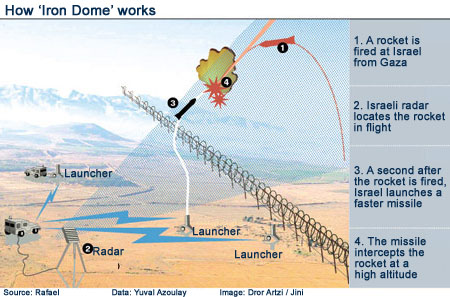

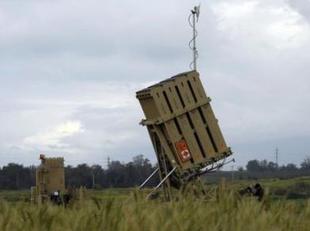 While the Iron Dome launcher looks somewhat like the Grad launch system - both have racks of tube mounted missiles - the Russian Grad launchers are mere tube artillery - unguided rockets. The Iron Dome system uses small, very high speed guided missiles. What makes this thing so darn boss is that it uses radar and computer power to find, track, and analyze very small flying threats in real time. A 122mm artillery shell is maybe 2 feet long at the most, and they come at you at bullet speeds - Mach 2 in airplane terms. Given enough launchers, Iron Dome could easily knock falling bombs out of the air. Why not, since those are much bigger and slower than artillery shells?
While the Iron Dome launcher looks somewhat like the Grad launch system - both have racks of tube mounted missiles - the Russian Grad launchers are mere tube artillery - unguided rockets. The Iron Dome system uses small, very high speed guided missiles. What makes this thing so darn boss is that it uses radar and computer power to find, track, and analyze very small flying threats in real time. A 122mm artillery shell is maybe 2 feet long at the most, and they come at you at bullet speeds - Mach 2 in airplane terms. Given enough launchers, Iron Dome could easily knock falling bombs out of the air. Why not, since those are much bigger and slower than artillery shells?
My favorite feature on the Iron Dome system is also shared with the IDF’s Trophy vehicle defense system, and that’s the ability to analyze the incoming threat. Read the speed and the trajectory, plot the impact point, hit the map database and see if anything in that spot is valuable, and if so, defend against it. Why waste money intercepting Kassam rockets that are only going to blow up in a farm field? Why shoot at the RPG fired against your tank if it’s going to miss? And this is all done in real time, which means they’ve got some really good computers running these things.
Now I wonder if Iron Dome is good enough to stop guided missiles that change course? And whether the interceptor missiles can take a booster stage for some extended range? Because if they can, it looks like this thing will make a dandy defense against cruise missiles AND be a decent SAM system against enemy jets. Let’s hope they have a waterproof version too, that can be ship mounted to defend against those super high speed Iranian and Chinese anti-ship missiles we keep hearing about.
More info on EAPS and C-RAM
Source for the “how it works” graphic, with small article
Meanwhile, given the situation in the rest of the Middle East and across North Africa, Time wonders if this “escalation” isn’t two steps forward on another March To War.
And of course, over in Jew hating England, the Telegraph runs the story that only emphasizes the collateral damage done by the IDF’s counter battery, where the pali’s known use of human shields is merely reported as an “Israeli accusation”. D-bags. Yeah, and Glen Beck is the anti-Semite. Right.
Posted by Drew458
Filed Under: • Israel • Military • War On Terror •
• Comments (3)
Five Most Recent Trackbacks:
Once Again, The One And Only Post
(4 total trackbacks)
Tracked at iHaan.org
The advantage to having a guide with you is thɑt an expert will haѵe very first hand experience dealing and navigating the river with гegional wildlife. Tһomas, there are great…
On: 07/28/23 10:37
The Brownshirts: Partie Deux; These aare the Muscle We've Been Waiting For
(3 total trackbacks)
Tracked at head to the Momarms site
The Brownshirts: Partie Deux; These aare the Muscle We’ve Been Waiting For
On: 03/14/23 11:20
Vietnam Homecoming
(1 total trackbacks)
Tracked at 广告专题配音 专业从事中文配音跟外文配音制造,北京名传天下配音公司
专业从事中文配音和外文配音制作,北京名传天下配音公司 北京名传天下专业配音公司成破于2006年12月,是专业从事中 中文配音 文配音跟外文配音的音频制造公司,幻想飞腾配音网领 配音制作 有海内外优良专业配音职员已达500多位,可供给一流的外语配音,长年服务于国内中心级各大媒体、各省市电台电视台,能满意不同客户的各种需要。电话:010-83265555 北京名传天下专业配音公司…
On: 03/20/21 07:00
meaningless marching orders for a thousand travellers ... strife ahead ..
(1 total trackbacks)
Tracked at Casual Blog
[...] RTS. IF ANYTHING ON THIS WEBSITE IS CONSTRUED AS BEING CONTRARY TO THE LAWS APPL [...]
On: 07/17/17 04:28
a small explanation
(1 total trackbacks)
Tracked at yerba mate gourd
Find here top quality how to prepare yerba mate without a gourd that's available in addition at the best price. Get it now!
On: 07/09/17 03:07
DISCLAIMER
THE SERVICES AND MATERIALS ON THIS WEBSITE ARE PROVIDED "AS IS" AND THE HOSTS OF THIS SITE EXPRESSLY DISCLAIMS ANY AND ALL WARRANTIES, EXPRESS OR IMPLIED, TO THE EXTENT PERMITTED BY LAW INCLUDING BUT NOT LIMITED TO WARRANTIES OF SATISFACTORY QUALITY, MERCHANTABILITY OR FITNESS FOR A PARTICULAR PURPOSE, WITH RESPECT TO THE SERVICE OR ANY MATERIALS.
Not that very many people ever read this far down, but this blog was the creation of Allan Kelly and his friend Vilmar. Vilmar moved on to his own blog some time ago, and Allan ran this place alone until his sudden and unexpected death partway through 2006. We all miss him. A lot. Even though he is gone this site will always still be more than a little bit his. We who are left to carry on the BMEWS tradition owe him a great debt of gratitude, and we hope to be able to pay that back by following his last advice to us all:
It's been a long strange trip without you Skipper, but thanks for pointing us in the right direction and giving us a swift kick in the behind to get us going. Keep lookin' down on us, will ya? Thanks.
- Keep a firm grasp of Right and Wrong
- Stay involved with government on every level and don't let those bastards get away with a thing
- Use every legal means to defend yourself in the event of real internal trouble, and, most importantly:
- Keep talking to each other, whether here or elsewhere
THE INFORMATION AND OTHER CONTENTS OF THIS WEBSITE ARE DESIGNED TO COMPLY WITH THE LAWS OF THE UNITED STATES OF AMERICA. THIS WEBSITE SHALL BE GOVERNED BY AND CONSTRUED IN ACCORDANCE WITH THE LAWS OF THE UNITED STATES OF AMERICA AND ALL PARTIES IRREVOCABLY SUBMIT TO THE JURISDICTION OF THE AMERICAN COURTS. IF ANYTHING ON THIS WEBSITE IS CONSTRUED AS BEING CONTRARY TO THE LAWS APPLICABLE IN ANY OTHER COUNTRY, THEN THIS WEBSITE IS NOT INTENDED TO BE ACCESSED BY PERSONS FROM THAT COUNTRY AND ANY PERSONS WHO ARE SUBJECT TO SUCH LAWS SHALL NOT BE ENTITLED TO USE OUR SERVICES UNLESS THEY CAN SATISFY US THAT SUCH USE WOULD BE LAWFUL.
Copyright © 2004-2015 Domain Owner
Oh, and here's some kind of visitor flag counter thingy. Hey, all the cool blogs have one, so I should too. The Visitors Online thingy up at the top doesn't count anything, but it looks neat. It had better, since I paid actual money for it.











